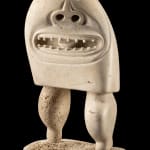-
Artworks
KAROO ASHEVAK (1940-1974) TALOYOAK (SPENCE BAY)
Shaman, c. 1972whalebone, stone, and ivory, 15 x 10 x 7 in (38.1 x 25.4 x 17.8 cm)
signed, "ᑲᔪ".
LOT 81
ESTIMATE: $90,000 — $120,000
PRICE REALIZED: $102,000.00Further images
-
(View a larger image of thumbnail 1
)

-
(View a larger image of thumbnail 2
)

-
(View a larger image of thumbnail 3
)

-
(View a larger image of thumbnail 4
)

-
(View a larger image of thumbnail 5
)

-
(View a larger image of thumbnail 6
)

-
(View a larger image of thumbnail 7
)

-
(View a larger image of thumbnail 8
)

-
(View a larger image of thumbnail 9
)

Karoo Ashevak revolutionized Inuit sculpture in the early 1970s. His willingness to explore the world of dreams, spirituality and shamanism in an uninhibited manner, his love of materials, tools and...Karoo Ashevak revolutionized Inuit sculpture in the early 1970s. His willingness to explore the world of dreams, spirituality and shamanism in an uninhibited manner, his love of materials, tools and tinkering, and the exuberance with which he seemed to approach every aspect of his life combined to produce an impressive body of startling “surreal” sculptures the likes of which had never been seen before. His work energized Inuit art collectors and importantly, attracted crossover collectors as well. Interestingly, it may be that Ashevak, one of the truly great geniuses of Inuit art, carved shamans and spirits partly in order to exorcise his childhood fear of them. His sister Eeteemunga Niviaqsiaq shared some interesting memories and thoughts in Darlene Wight’s 2000 Netsilik catalogue:
There were many spirits in his carvings. Before the Qabloona came, there were lots of angakuqs [shamans] and spirits. Our father talked a lot about angakuqs and ghosts when we were small, and I know Ashevak was afraid of them. After he grew up, he laughed at what he used to be afraid of. He would carve those spirits and angakuqs that he was afraid of. They were no longer frightening for him, and that’s why he would laugh. He was very easy to scare when he was young [1]. (Note: Karoo Ashevak is known as Ashivak Karruq in his home community of Taloyoak.)
Shaman, carved c. 1972, is a relatively early masterpiece that already possesses all the hallmarks of Karoo’s mature style. (It is astonishing to think that the artist had come so far in a scant two years, but of course Ashevak’s entire career was sadly compressed into a mere five years. Incredible.) The sculpture is brilliantly conceived as a truncated, stripped-down Janus-head on legs, and meticulously crafted using only the artist’s basic array of chosen tools: a carpenter’s saw, files, and a drill. Judy McGrath writes:
Whalebone is not an easy medium to work in. The most beautiful pieces are fossilized and centuries old, collected from the midden heaps of a preceding culture. The physical qualities of the bone are uncertain. The piece of bone may be as fragile and as delicate as lace in one place – rock-hard and impossible to carve in another. The bone may crack or split after hours of effort. One of Ashevak’s strengths is his ability to use the bone’s weakness as an integral part of his creations [2].
The double figure is ambiguous in form; has Ashevak done away with the heads or the bodies? The figure lacks arms as well, and clearly doesn’t need these extraneous elements, for the sculpture’s powerful visual and psychological impact relies on the two remarkably expressive and quite different faces. We know that Ashevak chose his materials with great care, so it is deliberate that one side is hard, solid bone while the other is more porous and weathered-looking. And the fact that each face has one leg to match is no accident either. We cannot help but compare this sculpture to one of Ashevak’s greatest works, The Coming and Going of the Shaman of c. 1973, which utilizes differing textures to great effect (see Hessel, Inuit Art, fig. 90). As with so many of Ashevak’s masterpieces, the meaning remains a bit of a mystery. Outstanding.
1. From a 1996 interview with Eeteemunga Niviaqsiaq in Wight, Art & Expression of the Netsilik, 2000, p. 66.
2. McGrath, “Introduction” in Karoo Ashevak: Spirits, 1973, unpag.
References: Jean Blodgett's landmark retrospective show and catalogue Karoo Ashevak, (Winnipeg: Winnipeg Art Gallery, 1977) illustrates ten sculptures from 1972 (cats. 18-27). See also American Indian Arts Center, Karoo Ashevak: Spirits, (New York: American Indian Arts Center, 1973); Gerald McMaster, ed., Inuit Modern: The Samuel and Esther Sarick Collection, (Toronto: Art Gallery of Ontario, 2010), pp. 118-119; Ingo Hessel, Inuit Art: An Introduction, (Vancouver: Douglas & McIntyre / New York: Harry Abrams / London: British Museum Press, 1998), figs. 89-90, pp. 111-112; First Arts Auction, 12 July 2020, Lot 40.
Provenance
Waddington’s, Toronto, 30 May 30 1989, Lot 616;
Private Collection;
Waddington's, Toronto, 29 May 2018, Lot 75;
Acquired from the above by the present Private Collection, Toronto.
-
(View a larger image of thumbnail 1
)
Join our mailing list
* denotes required fields
We will process the personal data you have supplied in accordance with our privacy policy (available on request). You can unsubscribe or change your preferences at any time by clicking the link in our emails.









